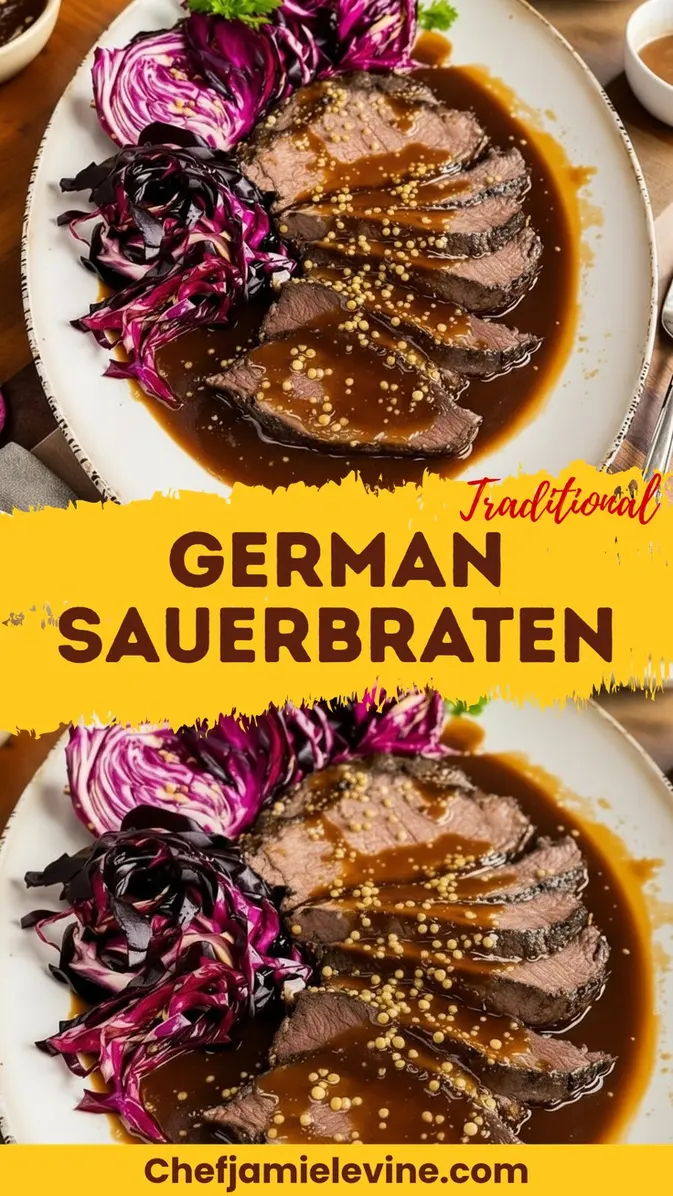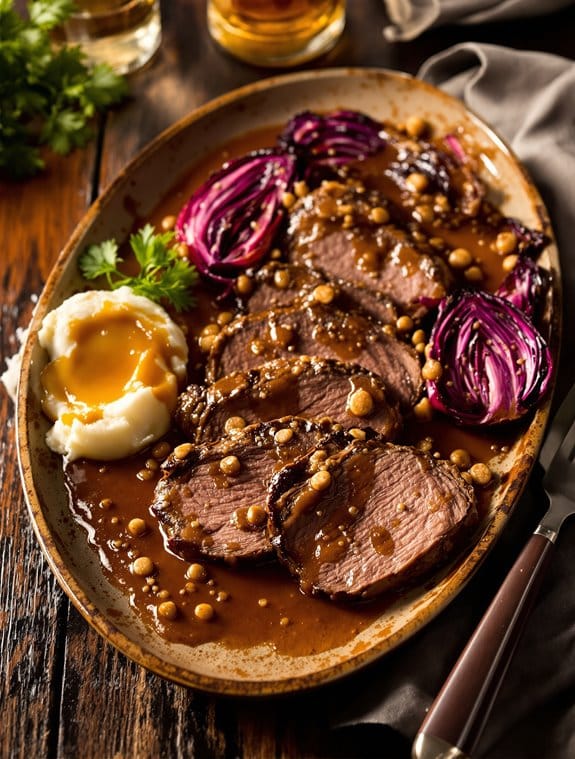Why You’ll Love this Authentic German Sauerbraten
If you’ve ever wanted to taste the rich culinary heritage of Germany without booking a flight, this authentic Sauerbraten recipe is your ticket to traditional German cuisine right in your own kitchen. I’m obsessed with how the tangy marinade transforms tough chuck roast into melt-in-your-mouth perfection over several days.
The secret? Those crushed gingersnaps that create a velvety, slightly sweet gravy you can’t get anywhere else. Yes, it requires patience—turning the meat twice daily with wooden spoons, never piercing—but trust me, that first forkful of tender beef alongside cabbage wedges will transport you straight to a cozy German gasthaus.
What Ingredients are in Authentic German Sauerbraten?
Authentic German Sauerbraten is all about layers of flavor that develop over several days of marinating. The ingredients might seem like an unusual combination at first glance—I mean, who thinks to put gingersnap cookies in a savory beef dish? But this is exactly what makes Sauerbraten such a unique culinary experience.
The tangy marinade tenderizes the meat while infusing it with complex flavors, and that signature gravy? It’s unlike anything you’ll taste in other beef dishes.
- 3 1/2-4 pounds boneless beef chuck roast
- 6 whole cloves
- 1 cup boiling water
- 2 bay leaves
- 2 teaspoons salt
- 2 onions, sliced into rings
- 1 1/2 cups red wine vinegar
- 12 peppercorns
- 12 juniper berries
- 1 medium head of cabbage, cut into 8 wedges
- 2 tablespoons shortening
- 2 teaspoons sugar
- 12 gingersnap cookies, crushed
- Toothpicks (for securing cabbage wedges)
When shopping for these ingredients, don’t skip the juniper berries—they’re essential for that authentic German flavor profile.
Can’t find them at your regular grocery store? Try specialty food shops or online retailers.
And about those gingersnaps: while it might be tempting to substitute another cookie, the spicy-sweet notes they provide are what gives Sauerbraten its distinctive taste.
The quality of your vinegar matters too, so opt for a good red wine vinegar rather than plain white vinegar, which would be too harsh and one-dimensional for this complex dish.
How to Make this Authentic German Sauerbraten

Making authentic Sauerbraten starts with patience—this isn’t a last-minute dinner idea, friends.
Begin by wiping your 3½-4 pound boneless beef chuck roast with a damp cloth and placing it in a plastic container with a lid. The marinade is where the magic happens: combine 6 whole cloves, 1 cup boiling water, 2 bay leaves, 2 teaspoons salt, 2 sliced onions, 1½ cups red wine vinegar, 12 peppercorns, and 12 juniper berries. Pour this aromatic mixture over the meat, cover, and let it rest in the refrigerator for 3 to 6 days. Remember to turn the meat twice daily using wooden spoons—never pierce it with a fork or you’ll lose those precious juices.
When you’re finally ready to cook (after what feels like forever), remove the meat from the marinade but save that liquid gold—it’s the foundation of your gravy. Heat 2 tablespoons of shortening in a large skillet and slowly brown the meat on both sides until it develops a rich crust.
Now add the reserved marinade, cover, and let it simmer for 2½ to 3 hours until the meat is fork-tender. I’m all about making life easier, so you could absolutely transfer everything to a crock-pot and cook on low for 6 to 8 hours instead. Just don’t overcook it, or you’ll end up with beef that’s more shredded than sliced.
For the final flourish, remove the meat and onions, keeping them warm while you prepare the signature gingersnap gravy. Strain the cooking liquid and add enough water to make 2½ cups. Return this to the skillet and add your 1 medium head of cabbage that’s been cut into 8 wedges (secured with toothpicks).
Cover and simmer for 10 minutes until the cabbage softens but still has some bite. Now for the unexpected twist—stir in 12 crushed gingersnap cookies and 2 teaspoons sugar into the liquid. Let it simmer for 3 more minutes as the cookies dissolve and thicken the gravy.
Remove those toothpicks from the cabbage wedges, arrange everything on a hot platter, and serve with that velvety, slightly sweet gingersnap gravy alongside. The contrast between the tangy meat and sweet-spiced gravy? Absolutely worth the wait.
Authentic German Sauerbraten Substitutions and Variations
While traditional recipes have their charm, sometimes we need to adapt based on what’s in our pantry or dietary restrictions.
If you can’t find juniper berries, substitute with a tablespoon of gin or a teaspoon of rosemary.
No gingersnaps? Crumbled graham crackers with a dash of ginger powder work surprisingly well.
For a lighter version, I’ve used apple cider vinegar instead of red wine vinegar—it gives a slightly sweeter tang.
Beef brisket or bottom round can replace chuck roast in a pinch.
And for those skipping red meat? A pork shoulder creates a different but equally delicious sauerbraten experience.
What to Serve with Authentic German Sauerbraten
No German feast is complete without proper accompaniments to your sauerbraten.
While the recipe includes cabbage with gingersnap gravy, I love adding a few more traditional sides to round out the meal. Spätzle, those tiny egg noodles, are perfect for soaking up that rich, tangy sauce. Can you imagine anything better?
Potato dumplings (kartoffelklöße) or simple boiled potatoes also work beautifully.
For a touch of brightness, try serving red cabbage (rotkohl) alongside the regular cabbage—the sweet-tart flavor complements the meat perfectly. A crisp German beer or glass of Riesling? That’s what I call dinner perfection.
Final Thoughts
After spending time with this authentic sauerbraten recipe, I’ve come to appreciate why it’s considered a crown jewel of German cuisine. The multi-day marinating process isn’t just tradition—it’s culinary magic that transforms tough chuck roast into fork-tender perfection.
Yes, patience is required. But when you slice into that aromatic meat, surrounded by gingersnap-infused gravy and tender cabbage, you’ll understand why generations have treasured this dish. Worth every minute of waiting, don’t you think?
This labor of love reminds us that sometimes, the most memorable meals aren’t quick fixes but slow-building masterpieces.
German comfort food at its finest.

German Sauerbraten
Ingredients
Equipment
Method
- Wipe the beef chuck roast with a damp cloth and place in a plastic container with a lid.
- Prepare the marinade by combining cloves, boiling water, bay leaves, salt, sliced onions, red wine vinegar, peppercorns, and juniper berries.
- Pour the marinade over the meat, cover, and refrigerate for 3 to 6 days. Turn the meat twice daily using wooden spoons, never piercing it with a fork.
- When ready to cook, remove the meat from the marinade but reserve the liquid for the gravy.
- Heat shortening in a large skillet and brown the meat on all sides until it develops a rich crust.
- Add the reserved marinade to the skillet, cover, and simmer for 2½ to 3 hours until the meat is fork-tender.
- Remove the meat and onions, keeping them warm while preparing the gravy.
- Strain the cooking liquid and add enough water to make 2½ cups. Return this liquid to the skillet.
- Secure the cabbage wedges with toothpicks and add them to the liquid in the skillet.
- Cover and simmer for 10 minutes until the cabbage softens but still has some bite.
- Stir in the crushed gingersnap cookies and sugar. Simmer for 3 more minutes until the cookies dissolve and thicken the gravy.
- Remove the toothpicks from the cabbage wedges and arrange the meat, cabbage, and gravy on a hot platter before serving.



